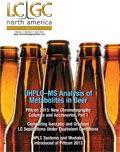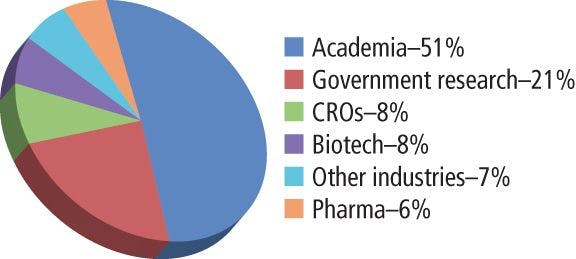Market Profile: Automated DNA Sequencers
Automating the DNA sequencing process is made possible by the use of fluorescent tags.
Automating the DNA sequencing process is made possible by the use of fluorescent tags. With fluorescent dyes, the entire experiment can be performed in a single solution instead of four different ones. Using Sanger-based methods, the DNA fragments migrate through the gel, and the color associated with each successive peak is detected using a laser. The DNA sequence is read by determining the sequence of colors in the peaks as they pass the detector. The data are then fed directly to a computer for instant results.

2011 DNA sequencing demand by industry.
Capillary electrophoresis (CE)-based DNA sequencing systems consist of a number of different measurements, all of which use an open fused-silica capillary tube filled with an electrolyte. The ends are immersed in reservoirs, held at high opposing potentials (+/-). Ions in the solution migrate to the oppositely charged ends. Silanol (-Si-OH) groups on the surface of the silica capillary give up hydrogen ions in alkaline media and produce a highly negatively charged surface, which in turn causes the carrier solution in the capillary to move toward the negative electrode. As a result, there is a constant flow of solution, produced by this electro-osmotic phenomenon, in the negative direction. The overall effect is to produce a separation in which, as a result of both the electrophoretic effect and the electro-osmotic flow, all anions move toward the cathode, but at different rates. An in-line detector can read all DNA fragments as they go by.
Next-generation sequencing systems have been the latest breakthrough in the automated DNA sequencing market. These sequencers employ similar chemistries, yet empower unique strategies. Roche's Genome Sequencer FLX system uses a combination emulsion polymerase chain reaction (PCR) and sequence by synthesis via pyrosequencing. Illumina's Genome Analyzer II also employs the sequencing-by-synthesis strategy. However, instead of emulsion PCR, the Genome Analyzer II uses a cluster amplification process by which clonal clusters are automatically generated on a flowcell. Life Technologies' SOLiD system uses emulsion PCR and microbeads that are transferred onto an open glass slide. The system employs a sequence by ligation strategy, using a two-base encoding chemistry.
SDi estimates that the top five industries account for about 93% of the market share. Academia accounts for more than half of the market share. Government research laboratories are responsible for 21%, followed by CROs, biotechnology, and pharmaceuticals with 8%, 7%, and 6%, respectively.
The foregoing data were extracted and adapted from SDi's recently published Global Assessment Report, 12th Edition. For more information, contact Glenn Cudiamat, VP of Research Services, Strategic Directions International, Inc., 6242 Westchester Parkway, Suite 100, Los Angeles, CA 90045, (310) 641-4982, fax: (310) 641-8851, e-mail: cudiamat@strategic-directions.com

Regulatory Deadlines and Supply Chain Challenges Take Center Stage in Nitrosamine Discussion
April 10th 2025During an LCGC International peer exchange, Aloka Srinivasan, Mayank Bhanti, and Amber Burch discussed the regulatory deadlines and supply chain challenges that come with nitrosamine analysis.
Top Execs from Agilent, Waters, and Bruker Take the Stage at J.P. Morgan Healthcare Conference
January 16th 2025The 43rd Annual Healthcare J.P. Morgan Healthcare Conference kicked off in San Francisco earlier this week. Here’s what top executives from Agilent, Bruker, and Waters, discussed during the event.






